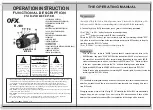
351R
azur
15
ENGLISH
3. Source setup
7KHQH[WVWHSLVWRVHOHFWHDFKVRXUFHLQSXWLQWXUQRQWKH5DQGWHOOWKH
unit:
• The type of audio connection you want to use for that source (Analogue,
Digital or HDMI).
• The processing mode for that source.
The 351R remembers these settings individually for every source input and
automatically recalls them as and when you change source input.
Select the 'Audio In. Select' menu. Highlight each source in turn and select
either analogue, digital or HDMI input types (use the
and
arrows):
Each source always has a dedicated HDMI input and a dedicated pair of
Analogue Stereo sockets associated with it on the back panel.
,QDGGLWLRQWKHUHDUHWZR63',)&R$[LDODQGRQHWRVOLQN2SWLFDOGLJLWDO
inputs available that can be freely assigned to any source.
For each source, pressing the Audio Input Type button thus scrolls through the
IROORZLQJ'0,$QDORJXH&R$[&R$[DQG2SW
+'0,DQG$QDORJXHUHIHUWRWKHGHGLFDWHGVRFNHWVIRUWKDWVRXUFH&R$[
&R$[ DQG 2SW UHIHU WR WKH WKUHH DVVLJQDEOH VRFNHWV WKDW DQ\ VRXUFH FDQ
select.
These digital inputs should only be selected (assigned) to one source each.
Analogue inputs will require a stereo phono/RCA to phono/RCA cable
connection to the 351R. Digital inputs will require either a 75ohm digital type
SKRQR5&$WRSKRQR5&$FRD[LDOFDEOH63',)RUDQRSWLFDOÀEUHFDEOH
(TOSLINK).
Note:
HDMI TV ARC is covered in a later section of this manual.
2QFH\RXKDYHVHWWKHDXGLRW\SHVH[LWWKH26'WRVDYH
This setting can also be changed at any time without using the OSD by
pressing the Audio Input Type button on the front panel or remote, this will
then cycle between analogue, digital or HDMI input types where available for
WKHFXUUHQWO\VHOHFWHGVRXUFHDVXVXDOWKH\ZLOOWKHQEHUHPHPEHUHGWKHQH[W
time you return to that source.
azur 351R
Audio In. Select
Tone/Sub Config.
Speaker Config.
Speaker Distance
Speaker Level
Speaker Xover
Auto Setup
Dolby/DTS Setup
OSD Setup
BD/DVD
CD
Video
Aux
HDMI TV ARC
Quit : [I/O]
Enter : [ENTER]
HDMI <>
HDMI <>
Analog <>
Analog <>
Enabled <>
Surround sound modes
The 351R supports several music and home-cinema listening modes. The
output the 351R can provide, depends both on the source signal present, the
speaker setup selected and the decode mode selected. Before we describe
how to operate the 351R, below is a brief guide to the Surround Sound
formats that the 351R is compatible with for reference:
Dolby's lossless audio technology developed primarily for high capacity
Blu-ray discs/players. Dolby True HD delivers theoretically bit-for-bit sound
identical to the studio master by the use of 100% lossless encoding. Previous
formats such as Dolby Digital 5.1 or EX have used lossy encoding where some
data (that is theoretically less audible) is always lost in the encoding process
to reduce the storage capacity needed on the disc. This is a new format that
supports 5.1 full-range channels of 24-bit/96 kHz audio or two channels of
24/192 kHz via Blu-ray discs and is not backwards compatible with earlier
schemes. The format can either be transmitted as a 'bitstream' to the 351R
for internal decoding (recommended) or can be decoded by some Blu-ray
players internally and sent to the 351R as multi-channel PCM. In both cases
an HDMI connection is required to the 351R and a suitable Blu-ray player as
Dolby True HD is only ever transmitted over HDMI.
An encoding scheme based on the original Dolby Digital CODEC, but with
HQKDQFHPHQWV WR LPSURYH FRGLQJ HIÀFLHQF\ DQG LPSURYHG DXGLR TXDOLW\
These Dolby Digital Plus bitstreams are not backward compatible with legacy
Dolby Digital decoders but require an AV Receiver developed to decode them
(such as the 351R) and an HDMI connection as Dolby Digital Plus is currently
only transmitted over HDMI. It is however a requirement that any Dolby Digital
Plus enabled Blu-ray player must also be able transform the Dolby Digital
Plus into a backwards compatible Dolby Digital 5.1 output for playback on
legacy Dolby Digital systems. The 351R is however fully compatible with Dolby
Digital Plus.
A new lossless audio codec from DTS, rather than being incompatible with
HDUOLHU YHUVLRQV '76+' 0DVWHU $XGLR LV WUDQVPLWWHG DV DQ H[WHQVLRQ WR D
normal DTS bitstream. A second embedded stream is sent which contains
the "difference" between the original studio master and the lossy compressed
DTS. DTS-HD Master Audio enabled devices (such as the 351R) are able to
use this difference information to recreate a bit for bit lossless version of
WKHRULJLQDOGDWD'HYLFHVZKLFKGRQRWVXSSRUWWKH0DVWHU$XGLRH[WHQVLRQ
simply decode the original 5.1 DTS stream and ignore the Master Audio
H[WHQVLRQSURYLGLQJEDFNZDUGVFRPSDWLELOLW\
DTS-HD High Resolution Audio
.QRZQDOVRDV'76+5DQH[WHQVLRQWRWKHRULJLQDO'76DXGLRIRUPDW'76+'
High Resolution Audio supports fully discrete channels compared to DTS's
5.1. As with DTS-HD Master Audio a second embedded stream is sent which
contains the "difference" between the original studio master and the lossy
FRPSUHVVHG '76 KRZHYHU LQ WKLV FDVH WKH H[WUD VWUHDP LV DOVR IRUPHG E\
lossy compression.
Known also as DD (3/2) or DD 5.1, provides (up to) 5.1 output from suitable
encoded Dolby Digital material, with 5 main channels (Front Left, Front Right,
Centre, Surround Left, Surround Right) and a Low Frequency Effects Channel
for the subwoofer, all discretely encoded. Decoding Dolby Digital requires
a Dolby Digital encoded DVD disc and a digital connection from the source
equipment (Such as a DVD player) to the 351R.
Note: Dolby Digital and DTS formats can sometimes carry less channels
WKDQWKHLUPD[LPXPVXFKDV'ROE\'LJLWDOZKLFKPHDQVD'ROE\'LJLWDO
encoded signal which is actually only carrying a two channel stereo signal
(other channels inactive).
Known also as DTS (3/2) or DTS 5.1, DTS provides (up to) 5.1 output from
suitable encoded DTS material, with 5 main channels (Front Left, Front Right,
Centre, Surround Left, Surround Right) and a Low Frequency Effects Channel
for the subwoofer, all discretely encoded. Decoding DTS requires a suitably
encoded DTS disc and a digital connection from the source equipment to
the 351R.














































